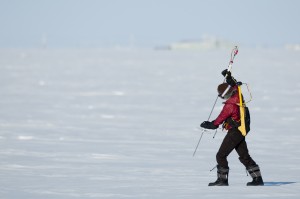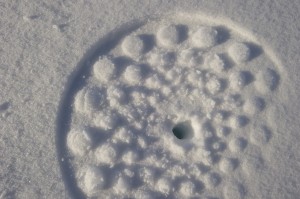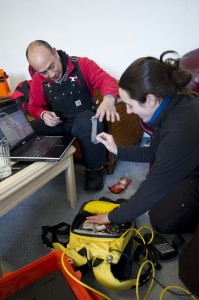13 August 2014
WASHINGTON, D.C. — Scientists have been tracking snow depth on Arctic sea ice for almost a century, using research stations on drifting ice floes and today’s radar-equipped aircraft. Now that people are more concerned than ever about what is happening at the poles, a new study confirms that snow has thinned significantly in the Arctic, particularly on sea ice in western waters near Alaska.

Researcher Melinda Webster uses a probe to measure snow depth and verify airborne data. She is walking on sea ice near Barrow, Alaska in March 2012. Her backpack holds electronics that power the probe and record the data.
Chris Linder / Univ. of Washington
The new assessment, accepted for publication in the Journal of Geophysical Research: Oceans, a publication of the American Geophysical Union, combines data collected by ice buoys and NASA aircraft with historic data from ice floes staffed by Soviet scientists from the late 1950s through the early 1990s to track changes over decades.
Historically, Soviets on drifting sea ice used meter sticks and handwritten logs to record snow depth. Today, researchers on the ground use an automated probe similar to a ski pole to verify the accuracy of airborne measurements.
“When you stab it into the ground, the basket moves up, and it records the distance between the magnet and the end of the probe,” said Melinda Webster, a graduate student in oceanography at the University of Washington (UW), Seattle, and first author on the study. “You can take a lot of measurements very quickly. It’s a pretty big difference from the Soviet field stations.”
Webster verified the accuracy of airborne data taken during a March 15, 2012 NASA flight over the sea ice near Barrow, Alaska. The following day Webster followed the same track in minus 30-degree temperatures while stabbing through the snow every two to three steps.

The probe, shaped like a ski pole, includes a basket that stays on top of the snow while the tip of the probe plunges down to the sea ice below.
Chris Linder / Univ. of Washington
The authors compared data from NASA airborne surveys, collected between 2009 and 2013, with U.S. Army Corps of Engineers buoys frozen into the sea ice, and earlier data from Soviet drifting ice stations in 1937 and from 1954 through 1991. Results showed that snowpack has thinned from 35 centimeters to 22 centimeters (14 inches to 9 inches ) in the western Arctic, and from 33 cm to 14.5 cm (13 in to 6 in) in the Beaufort and Chukchi seas, west and north of Alaska.
That’s a decline in the western Arctic of about a third, and snowpack in the Beaufort and Chukchi seas measures less than half as thick in spring in recent years compared to the average Soviet-era records for that time of year.
“Knowing exactly the error between the airborne and the ground measurements, we’re able to say with confidence, Yes, the snow is decreasing in the Beaufort and Chukchi seas,” said co-author Ignatius Rigor, an oceanographer at the UW’s Applied Physics Laboratory.
UW and NASA researchers led the study. The authors speculate the reason for the thinner snow, especially in the Beaufort and Chukchi seas, may be that the surface freeze-up is happening later in the fall so the year’s heaviest snowfalls, in September and October, mostly fall into the open ocean.
What thinner snow will mean for the ice is not certain. Deeper snow actually shields ice from cold air, so a thinner blanket may allow the ice to grow thicker during the winter. On the other hand, thinner snow cover may allow the ice to melt earlier in the springtime.
Thinner snow has other effects, Webster said, for animals that use the snow to make dens, and for low-light microscopic plants that grow underneath the sea ice and form the base of the Arctic food web.

Ignatius Rigor and Melinda Webster prepare the equipment to go out in the field.
Chris Linder / Univ. of Washington
The new results support a 15-year-old study, also led by the University of Washington, in which Russian and American scientists first analyzed the historic Arctic Ocean snow measurements. That paper detected a slight decline in spring snow depth that the authors believed, even then, was due to a shorter ice-covered season.
“This confirms and extends the results of that earlier work, showing that we continue to see thinning snow on the Arctic sea ice,” said Rigor, who was also a co-author on the earlier paper.
The recent fieldwork was part of NASA’s Operation IceBridge program, which is using aircraft to track changes while NASA prepares to launch a new ice-monitoring satellite in 2017. The team conducted research flights in spring 2012 as part of a larger program to monitor changes in the Arctic.
The research was supported by NASA and the U.S. Interagency Arctic Buoy Program.
The American Geophysical Union is dedicated to advancing the Earth and space sciences for the benefit of humanity through its scholarly publications, conferences, and outreach programs. AGU is a not-for-profit, professional, scientific organization representing more than 62,000 members in 144 countries. Join our conversation on Facebook, Twitter, YouTube, and other social media channels.
Notes for Journalists:
Journalists and public information officers (PIOs) of educational and scientific institutions who have registered with AGU can download a PDF copy of this accepted article by clicking on this link: http://onlinelibrary.wiley.com/doi/10.1002/2014JC009985/abstract
Or, you may order a copy of the final paper by emailing your request to Peter Weiss at [email protected]. Please provide your name, the name of your publication, and your phone number.
Neither the paper nor this press release is under embargo.
“Interdecadal changes in snow depth on Arctic sea ice”
Authors:
Melinda A. Webster: Polar Science Center, Applied Physics Laboratory, University of Washington, Seattle, Washington, USA;
Ignatius G. Rigor: Polar Science Center, Applied Physics Laboratory, University of Washington, Seattle, Washington, USA;
Son V. Nghiem: Jet Propulsion Laboratory, California Institute of Technology, Pasadena, California, USA;
Nathan T. Kurtz: Hydrospheric and Biospheric Sciences Laboratory, NASA Goddard Space Flight Center, Greenbelt, Maryland, USA;
Sinead L. Farrell: Hydrospheric and Biospheric Sciences Laboratory, NASA Goddard Space Flight Center, Greenbelt, Maryland, USA; and Earth System Science Interdisciplinary Center, University of Maryland, College Park, Maryland, USA;
Donald K. Perovich: US Army Corps of Engineers, Engineer Research and Development Center, Cold Regions Research and Engineering Laboratory, Hanover, New Hampshire, USA;
Matthew Sturm: Geophysical Institute, University of Alaska Fairbanks, Fairbanks, Alaska, USA.
Contact information for authors:
Melinda Webster: [email protected] . Webster is on travel until late August but will have email access at least once a day.
Ignatius Rigor: +1 (206) 685-2571, [email protected].